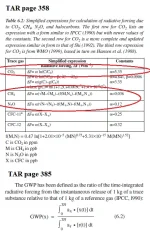- Joined
- Dec 22, 2012
- Messages
- 79,173
- Reaction score
- 26,971
- Location
- Portlandia
- Gender
- Male
- Political Leaning
- Libertarian - Right
RE (Radiative Efficiency) and GWP (Global Warming Potential) explained. I consider both RE and GWP nonsensical metrics for studying the climate system regarding greenhouse gasses. This is because the values are a linearized value between two points on a log curve and grow in error very fast.
RE is seen in the tables as to its calculation. It is the forcing value difference with 1 ppb (part per billion) of gas added. This makes it a slope of the graph between the gas levels and forcing levels of the two points. Because this is a linear slope, it does not follow the log curve, and this makes it an unrealistic metric to use.
GWP is similar, except it uses a kilogram added to the starting gas level instead of a ppb. Since CH4 has a molar mass of 16, and CO2 a molar mass of 44, the metric is using 2.75 time CH4 as CO2 for comparisons.
Here is what the IPCC uses for the greenhouse formulas. It is found on page 358 of the TAR (Third Assessment Report) WG1 (Working Group 1). I circled the formulas from Table 6.2 that I used to make the graph. GWP formula and explanation is found on page 385 of the TAR.
The graph I presented matches the numbers for RE as found in Table 2.1 of the AR5 (5th Assessment report). Table 8.A.1 has N2O at a different RE, which really bugs me about the IPCC. They have errors found now and again. I included it because it shows the GWP numbers for the AR5.


Here is the graph that I made using the IPCC AR5 WG1 numbers, and formula found in the TAR WG1:

Now look at the numbers also. My RE slopes are 1000 times greater than the RE values of the IPCC. That is because I graphed the X-Axis in ppm (parts per million) instead of ppb (parts per billion). They are otherwise the same. Small changes will matter little so I will show the connection between RE and GWP. We will start by using RE of CO2 and CH4. 3.63e-4 / 1.37e-5 = 26.5. Since GWP uses mass instead of volume, we multiply this by the mass ratio of the two molecules, or 2.75. 26.5 x 2.75 = 72.9. This is close to the GWP of 84 used by the IPCC for the 20 year horizon.
Note the scaling between the gasses on the graph. At equal levels, CO2 is much greater than CH4. Notice that the RE trend lines fall away from the actual gas curve very quickly. It is a lie to say the CH4 is the stronger greenhouse gas. It just has a greater forcing increase per the same amount of added gas.
Don’t let the scare tactic of using GWP affect you. It has no real meaning.
Any questions?
RE is seen in the tables as to its calculation. It is the forcing value difference with 1 ppb (part per billion) of gas added. This makes it a slope of the graph between the gas levels and forcing levels of the two points. Because this is a linear slope, it does not follow the log curve, and this makes it an unrealistic metric to use.
GWP is similar, except it uses a kilogram added to the starting gas level instead of a ppb. Since CH4 has a molar mass of 16, and CO2 a molar mass of 44, the metric is using 2.75 time CH4 as CO2 for comparisons.
Here is what the IPCC uses for the greenhouse formulas. It is found on page 358 of the TAR (Third Assessment Report) WG1 (Working Group 1). I circled the formulas from Table 6.2 that I used to make the graph. GWP formula and explanation is found on page 385 of the TAR.
The graph I presented matches the numbers for RE as found in Table 2.1 of the AR5 (5th Assessment report). Table 8.A.1 has N2O at a different RE, which really bugs me about the IPCC. They have errors found now and again. I included it because it shows the GWP numbers for the AR5.


Here is the graph that I made using the IPCC AR5 WG1 numbers, and formula found in the TAR WG1:

Now look at the numbers also. My RE slopes are 1000 times greater than the RE values of the IPCC. That is because I graphed the X-Axis in ppm (parts per million) instead of ppb (parts per billion). They are otherwise the same. Small changes will matter little so I will show the connection between RE and GWP. We will start by using RE of CO2 and CH4. 3.63e-4 / 1.37e-5 = 26.5. Since GWP uses mass instead of volume, we multiply this by the mass ratio of the two molecules, or 2.75. 26.5 x 2.75 = 72.9. This is close to the GWP of 84 used by the IPCC for the 20 year horizon.
Note the scaling between the gasses on the graph. At equal levels, CO2 is much greater than CH4. Notice that the RE trend lines fall away from the actual gas curve very quickly. It is a lie to say the CH4 is the stronger greenhouse gas. It just has a greater forcing increase per the same amount of added gas.
Don’t let the scare tactic of using GWP affect you. It has no real meaning.
Any questions?


